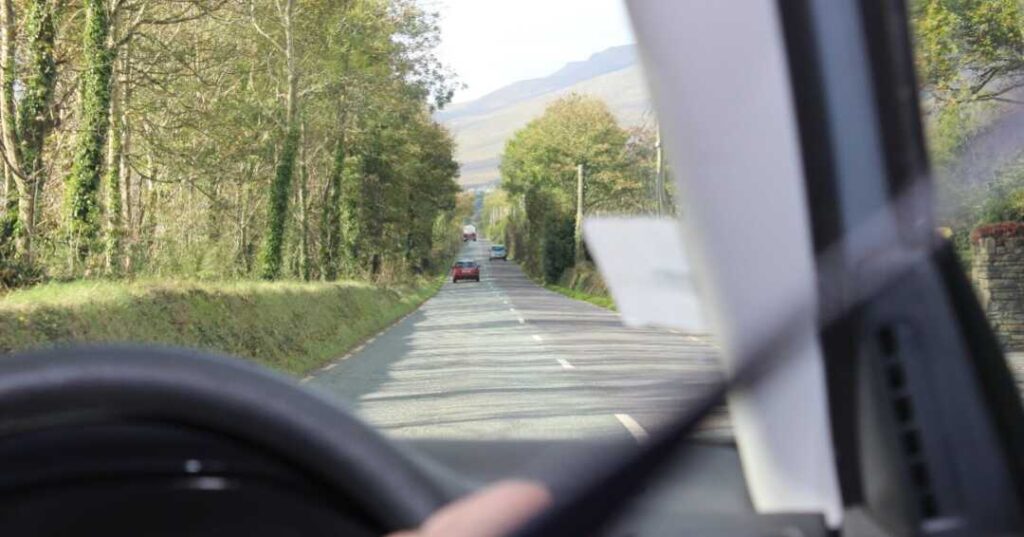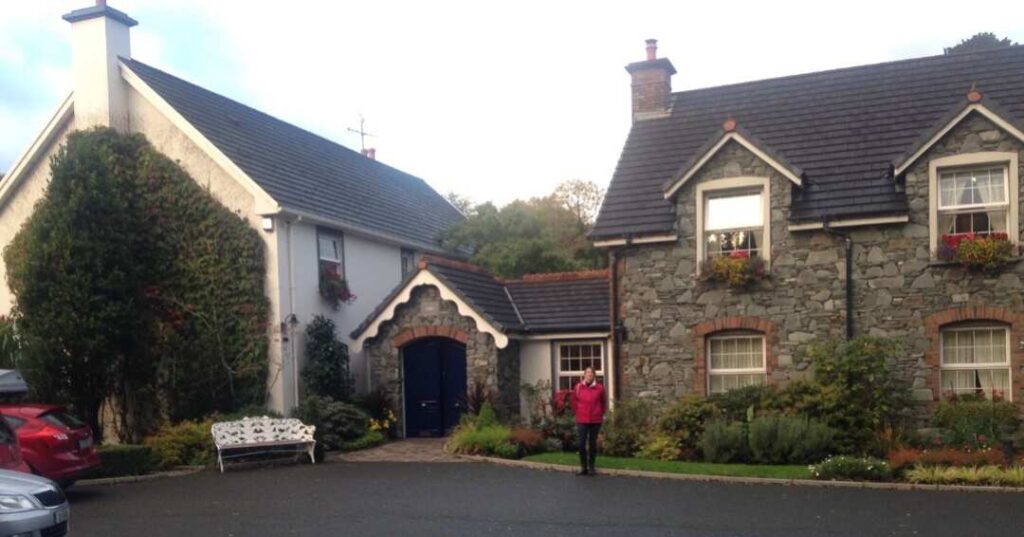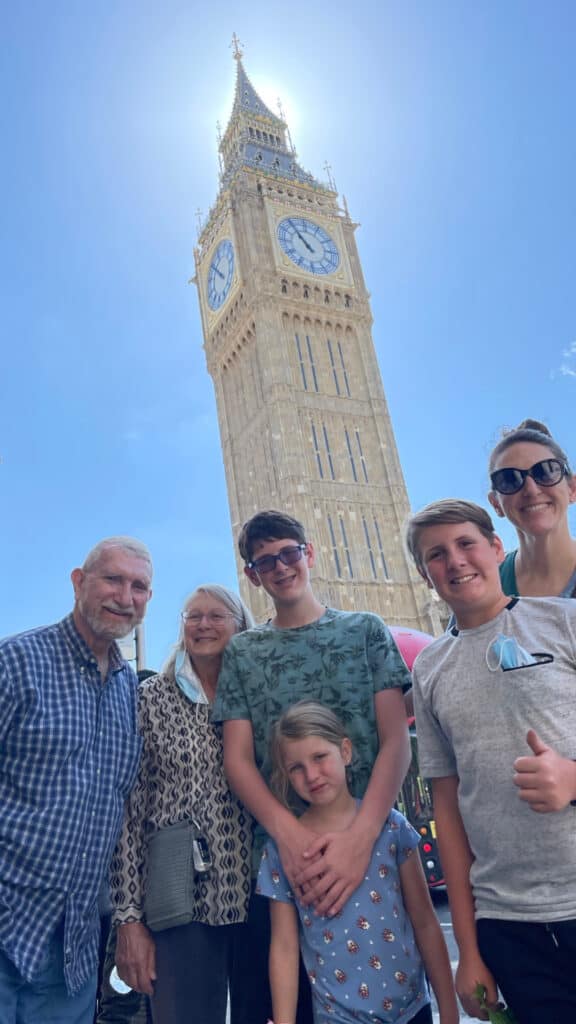If you are planning a trip to Ireland and thinking about renting a car, you might wonder “what side of the road do they drive on in Ireland?”
Navigating your way around a foreign country can be stressful, but preparing for the different customs and rules will help make your experience run smoothly.
We had a great time driving in Ireland thanks to my husband’s experience driving in Jamaica.
In Ireland, they drive on the left side of the road. This means that the driver sits on the right-hand side of the car and passes on the right.
Keep this in mind if you plan on driving in Ireland for the first time, as it can take some getting used to if you usually drive on the right hand side of the road.
Let’s dive into all the details about driving in Ireland as a tourist so you can feel prepared for your Irish adventure.
Note: This post has affiliate links from trusted partners and websites such as Amazon, and any purchases made through such links will result in a small commission for me (at no extra cost to you).
Why do they drive on the left side in Ireland?
The reason why people in Ireland drive on the left side of the road can be traced back to when Ireland was once part of the British Empire, and the British introduced left-hand traffic to the country. This practice continued even after Ireland gained independence from Britain in 1922.
The reasons behind the British adoption of left-hand traffic are not entirely clear. One theory suggests that it dates back to medieval times when knights would ride on the left hand side of the road to keep their sword arm free.
Regardless of the origins of left-hand traffic, it has been a longstanding tradition in Great Britain, Ireland, and other countries that were once part of the British Empire, such as Australia, India, and South Africa.
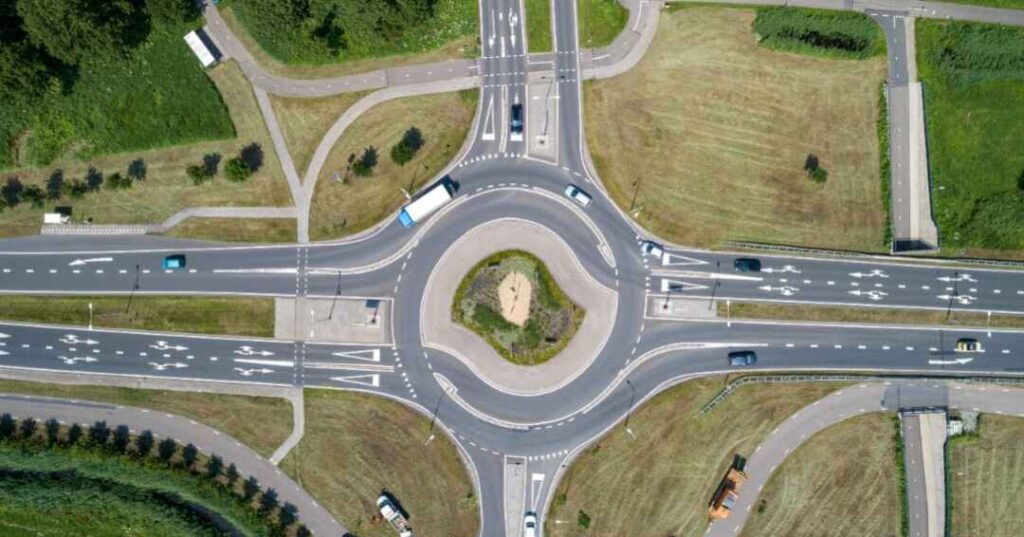
What Else do I Need to Know Before Driving in Ireland?
If you plan to be driving in Ireland, requirements are important things you should know before you hit the road. Here are some tips to help you drive safely and confidently in Ireland:
Drive on the left hand side of the road
Yep, I’ll say it again, in Ireland, like in the UK, traffic drives on the left side of the road. So the driver sits on the right-hand side of the car, and cars pass right if needed. It’s really important to remember what side of the road the Irish drive on since sometimes we can just go into auto-pilot when driving.
Be prepared for roundabouts
I love me some roundabouts. They are not as common here in America, but roundabouts are all over Ireland and can be confusing for drivers who are not used to them. Remember to yield to traffic already in the roundabout, and signal your intentions when entering and exiting.
Plan your route
Plan your route ahead of time, and make sure you have a GPS device in the car or on your phone, or detailed maps (does anyone use paper maps anymore?) to help you navigate. Some rural roads in Ireland can be narrow and winding, like ‘one-lane-I’m-going-to-fall-off-a cliff-if-another-person-comes’ narrow, so plan accordingly.
No matter where you drive in Ireland, it’s amazingly beautiful. Plan a mix of highways and smaller roads to really get the feel of the country. Need help planning? Check out our 7-Day Ireland Driving Itinerary below.
Drive cautiously
Ireland is not a place to be rushed. There is beauty around every turn. That being said, Irish roads can be narrow and winding, with unexpected dips and turns. Drive cautiously, especially on rural roads, and be prepared to share the road with pedestrians, cyclists, and farm vehicles. Take your time and enjoy the adventure.
Be aware of speed limits
Pay attention to speed limits and obey them at all times. Speed limits are indicated in kilometers per hour, and distances are measured in kilometers. Speeding fines in Ireland can be significant, and dangerous driving can result in license suspension or other penalties.
Speed limits in Ireland are generally in kilometers per hour (km/h) rather than miles per hour (mph), so it’s important to be aware of the conversion. In urban areas, the speed limit is typically 50 km/h (about 30 mph), while on rural roads it can be as high as 100 km/h (about 60 mph).
Read the road signs
The road signs and markings in Ireland are different than what drivers are used to in the US sometimes. For example, some road signs, such as yield signs and roundabout signs, may be different in appearance or placement.
In Ireland, road signs are written in both English and Irish (Gaelic). English is the primary language of the country, but Irish is also an official language, and therefore road signs are required to be bilingual. The Irish language versions of the road signs are in the traditional Irish script and are displayed directly below the English versions.
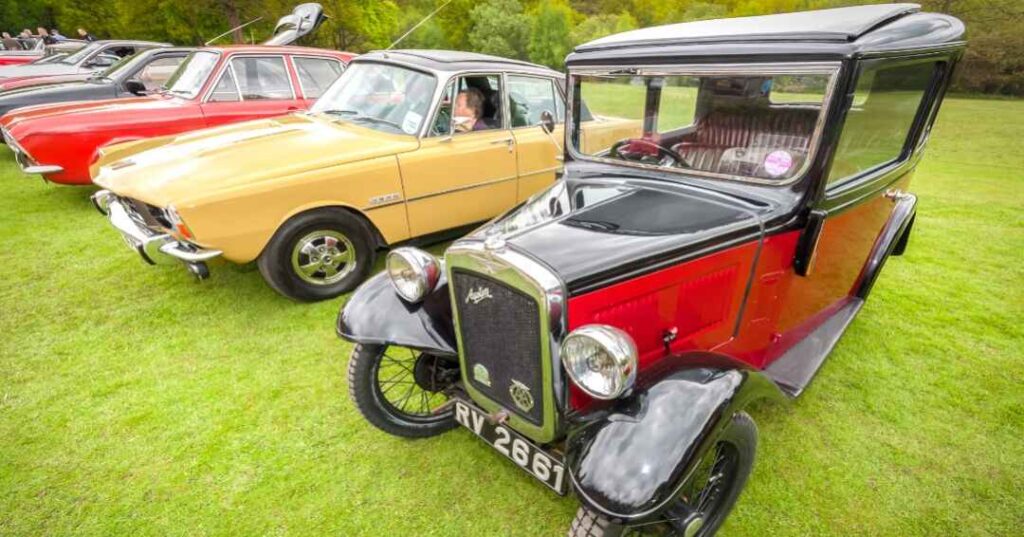
Irish Cars vs. American Cars
Irish cars and American cars are not significantly different from each other in terms of their design or functionality, but there are some differences that are important to note when it comes to driving on different sides of the road.
The main difference between Irish and American cars is the position of the steering wheel. In Irish (and British) cars, the steering wheel is on the right hand side of the car, while in American cars, the steering wheel is on the left hand side.
In addition to the steering wheel position, there are some other differences in the controls and instruments of British and American cars. For example, in Irish cars, the gear shift and handbrake are typically located on the left hand side of the driver, while in American cars, they are located on the right hand side. The location of other controls, such as the turn signal and windshield wipers, may also be different.
Which Side is the Gas Pedal on in Ireland?
In Ireland, like in the UK, the gas pedal (or accelerator) is on the right side of the car. The driver sits on the right-hand side of the car and operates the pedals with their right foot. The brake pedal is located on the left side of the car and is operated with the left foot. It can take some time to adjust to operating the pedals with your opposite foot if you’re not used to driving on the left-hand side of the road.
What Type of Fuel do Cars in Ireland Use?
Cars in Ireland use unleaded petrol (gasoline) or diesel as fuel. The type of fuel used by a car depends on the engine type and the manufacturer’s specifications. Most petrol stations in Ireland offer both unleaded petrol and diesel, as well as premium petrol and biofuels.
Just make sure you are using the correct type of fuel for your rental car since using the wrong type can damage the engine and lead to costly repairs.
Can you turn left on red in Ireland?
No, you cannot turn left on red in Ireland. In Ireland, you must come to a complete stop at a red traffic light, and you cannot proceed until the light turns green. Just follow all traffic signals and signs and obey Ireland’s driving rules of the road to ensure your safety and the safety of other drivers and pedestrians.
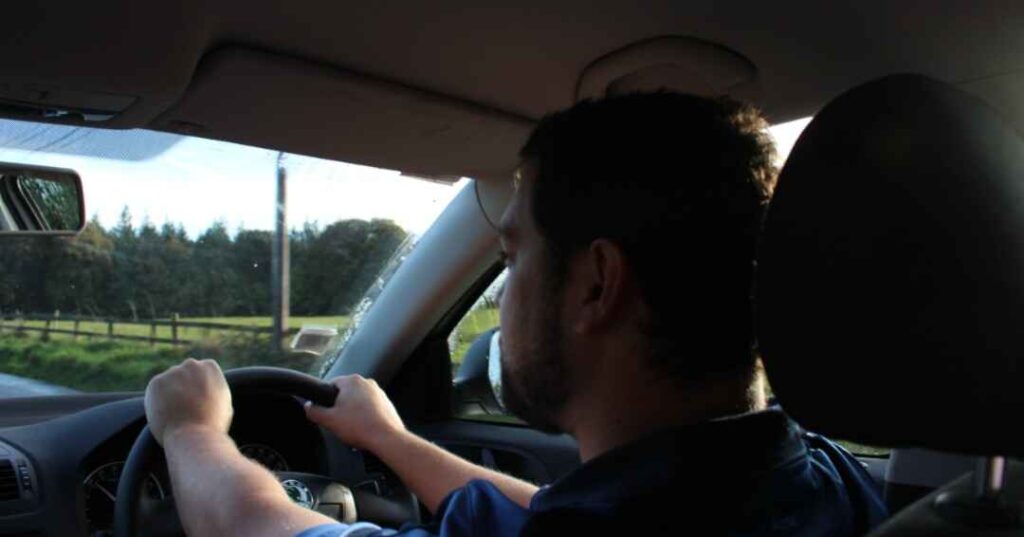
Speed limits in Ireland
In Ireland, the speed limit varies depending on the type of road and the location. The following are the standard speed limits in Ireland:
- 50 km/h (31 mph) in built-up areas, including towns and cities
- 80 km/h (50 mph) on most regional roads
- 100 km/h (62 mph) on national roads and some regional roads
- 120 km/h (75 mph) on motorways
However, it’s important to note that speed limits can be lower in certain areas, such as near schools or construction sites. Additionally, there may be variable speed limits in place on some roads, especially motorways, that change based on traffic or weather conditions.
Remember that there are different systems in the two countries of Ireland. The Republic of Ireland uses kilometers/hour and Northern Ireland uses miles/hour.
Toll roads in Ireland
Yes, there are toll roads in Ireland. The toll roads are mainly located in the Dublin area and along the main motorway network. The tolls are usually collected electronically, using a system called eFlow. This system involves cameras and sensors mounted on overhead gantries that record the registration plate of the vehicle and charge the toll to a pre-registered account or through a pay-as-you-go system.
Pro Travel Tip
Traffic in Ireland
In Ireland, traffic varies depending on the location and time of day. Traffic in major cities like Dublin, Cork, and Galway can be congested during peak commuting hours. Congestion will be heaviest around city centers.
Outside of the cities, the roads are generally less congested. They can still experience some delays during peak travel periods, such as weekends and holidays. Rural roads may also be narrower and more winding. Just drive with caution and be aware of other vehicles and potential hazards.
During the tourist season, traffic can be heavier than usual. This is true, particularly in popular destinations like the Ring of Kerry or the Cliffs of Moher. Make sure to allow extra time when planning your trip.
Is it hard for Americans to drive in Ireland?
if you are not used to driving on the left-hand side of the road, driving in Ireland as an American can be challenging. It can take some time to adjust to driving on the opposite side of the road.
That being said, many American visitors to Ireland do choose to rent a car and drive Ireland themselves, and with some practice and care, you can enjoy a safe and rewarding driving experience in Ireland like we did.
Some tips for driving in Ireland include:
- Take your time and drive cautiously, especially on narrow and winding roads.
- Familiarize yourself with the road signs and markings, and pay attention to speed limits and other rules of the road.
- Practice driving on the left on a side road in a quiet area before venturing out onto busier roads.
- If you are not comfortable driving in Ireland, just consider using public transportation or hiring a driver instead.
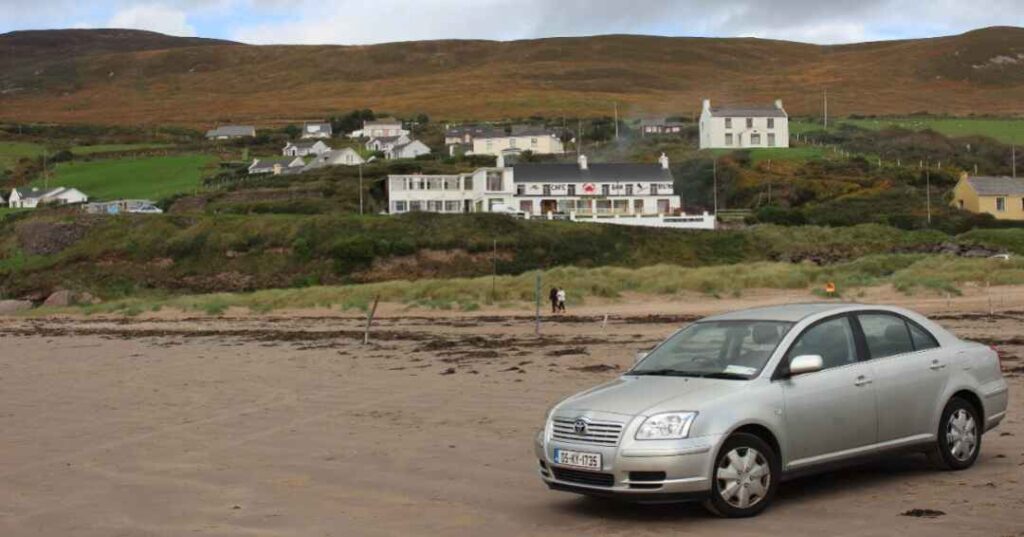
Renting a Car in Ireland
It is generally easy to rent a car in Ireland. There are many car rental companies in Ireland, both international and local, and you can book a rental car online or in person at the rental office.
Rental Cars
US driver’s licenses in Ireland
When renting a car in Ireland, you will need to have a valid driver’s license from your home country. Ireland recognizes driver’s licenses issued by most countries, including the United States.
However, if your driver’s license is not in English, you may also need an International Driving Permit (IDP) in order to legally drive in Ireland. An IDP translates your driver’s license into multiple languages and serves as a valid form of identification in many countries.
The minimum age for driving in Ireland is 18 years old, and some car rental companies may require you to be at least 21 years old to rent a car.
Rental Car Insurance in Ireland
You need insurance to rent a car in Ireland. Rental car companies in Ireland are required by law to provide basic insurance coverage for their vehicles, which typically includes third-party liability insurance and collision damage waiver (CDW) coverage. However, the exact coverage provided can vary depending on the rental company and the type of car you rent.
Basic insurance coverage is typically included in the rental rate. It is a good idea to consider additional insurance options, such as excess insurance. This is good to protect yourself against high deductibles or other unexpected costs in the event of an accident or damage to the rental car.
Before renting a car in Ireland, be sure to read and understand the insurance coverage provided by the rental company and consider purchasing additional insurance if necessary to ensure you have enough coverage for your needs. And make sure to give the car a good looking over to see if there is any damage prior to taking it out.
Travel Insurance
Travel Guard is a travel insurance that we used when we went to Ireland.
They cover so many issues you may experience while traveling. One of the parts of coverage is Rental Vehicle Damage Coverage.
Rental Car Payment Options
There are several ways to pay for a rental car in Ireland, including:
- Credit card: Most rental car companies in Ireland require a credit card for payment. Check with the rental company in advance to ensure that your credit card will be accepted.
- Debit card: Some rental car companies in Ireland may accept debit cards for payment, but this is not always the case. Be sure to check with the rental company in advance to see if they accept debit cards.
- Cash: You can pay for a rental car in cash, but not all rental companies accept cash. Be sure to check with the rental company in advance to see if they accept cash payments.
- Online payment: Many rental car companies in Ireland allow you to prepay for your rental car online using a credit card.
Most rental car companies in Ireland require a deposit when you pick up the car, which is usually held on your credit card until the car is returned. The amount of the deposit can vary depending on the rental company and the type of car you are renting.
Pro Travel Tip
Credit cards for travel
If you’re not using credit cards for travel hacking to get free flights, hotels, and activities, you’re missing out. You can learn all about free travel in our Travel Hacking Guide.
Here are our top travel credit cards with rental car perks (such as auto rental damage coverage):
Chase United Business Card
Capital One Venture
Best 3-Day Driving Itinerary for Southern Ireland
If you have limited time to explore southern Ireland, here is a suggested 3-day driving itinerary that will give you a taste of the region’s stunning landscapes, charming towns, and historic sites. Check out our more detailed 7-day Ireland Driving Itinerary.
+Day 1: Dublin to Kilkenny
- Depart Dublin and head south to Kilkenny, a medieval city known for its well-preserved historic buildings and narrow streets.
- Visit Kilkenny Castle and St. Canice’s Cathedral, and explore the city’s many pubs and restaurants.
- Make a visit to Waterford to tour the Waterford Crystal Factory.
*Day 2: Kilkenny to Killarney
- Drive south from Kilkenny to Killarney, a charming town located near the Ring of Kerry.
- Take a scenic drive around the Ring of Kerry, stopping at picturesque villages along the way.
+Day 3: Killarney to Cliffs of Moher and back to Dublin
- From Killarney, drive north to the Cliffs of Moher, one of Ireland’s most iconic natural attractions.
- Take in the stunning views of the Atlantic Ocean and explore the visitor center.
- From the Cliffs of Moher, drive east back to Dublin, stopping at historic towns and villages along the way.
Modify this itinerary based on your interests and time constraints. Be sure to give yourself enough time to explore each destination and take in the stunning scenery along the way.
Killarney is one of my most favorite spots in Ireland! I highly recommend staying at Friar’s Glen Country House and eating at Bricín Shop and Restaurant.
Travel Helps
Here are my top recommendations to make traveling a little easier.
Travel Insurance
Travelex Insurance – With over 55 years of experience protecting travel investments from the unknown, Travelex is a world leader in travel insurance. Their most popular features and benefits including trip cancellation, trip interruption, and bankruptcy and terrorism coverage. Travelex develops and delivers innovative insurance products and services at a competitive price, while delivering excellent service to our customers at all levels.
Attractions
Groupon – Groupon is a great way to find discounts for things to do on vacation. You can save money on fun activities for the whole family.
Viator– Viator delivers online and mobile access to thousands of trip activities including tours, attractions, shore excursions and private guides, in more than 1,500 destinations worldwide. I’ve used Viator for several family trips and they have all been great. They offer great prices, which is great for a family on a budget, and they have 24/7 customer service, so they are available to help you out whenever you need.
Cash-back app
Upside – If you are on a road trip, make sure to download this free cash-back app. Upside users earn up to 25¢/gallon cash back on gas, up to 45% cash back at restaurants, and up to 30% cash back at grocery stores.
Lodging
Hotels.com – Hotels.com® offers more than 1,000,000 properties in 200 countries – from hotels and B&B’s to condos and all-inclusive resorts. Earn free nights for every 10 nights booked with the Hotels.com Rewards program. Find hotels during sold-out periods. Book the perfect trip- backed by the Hotels.com Price Guarantee.
VRBO.com is cost effective and comfortable for family travel. You can customize the size, location, and budget of the accommodations for your next vacation. With over 2 million vacation rentals you are set to find the perfect place for your family’s next adventure.
Airfare
WayAway-WayAway provides travelers with the best rates on airline tickets and a WayAway Plus membership plan providing users with cash back on many travel services. It compares airfares offered by all major US and global airlines and agencies.
Conclusion: What side of the road do they drive on in Ireland?
If you’re renting a car in Ireland, remember that they drive on the left side of the road. Driving in Ireland was an amazing experience for us, and it allowed us to explore at our own pace and see exactly what suited us.
Need more ideas for where to visit in Ireland? We’ve got the perfect 7-day itinerary for driving in Ireland.

Kyleen Bontrager
The Bonnie TravelerKyleen is a wife, homeschool mama, lover of teatime, and passionate traveler. Having lived on 3 continents and visited +32 countries, she helps others enjoy memory-making experiences for multigenerational travel. Ready for a bonnie adventure? Let’s go!

